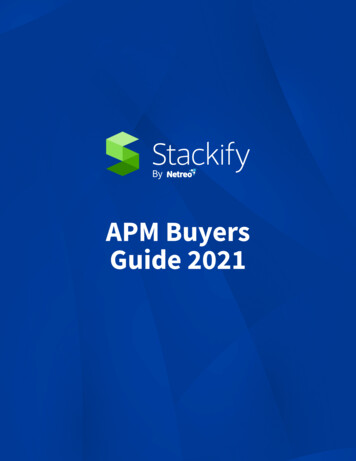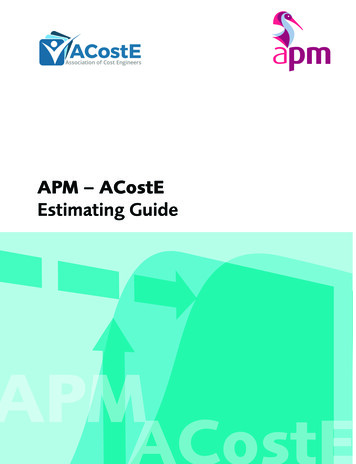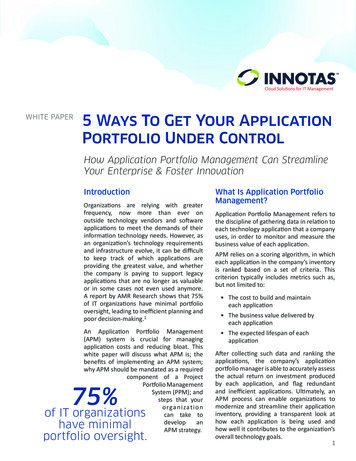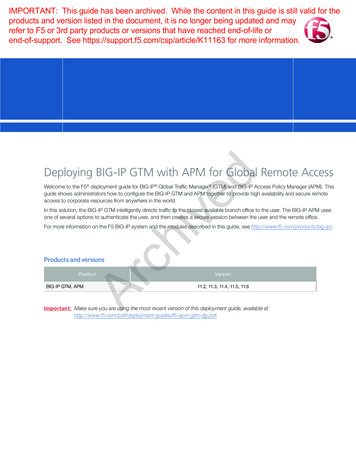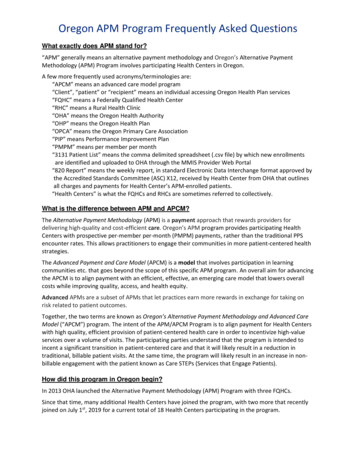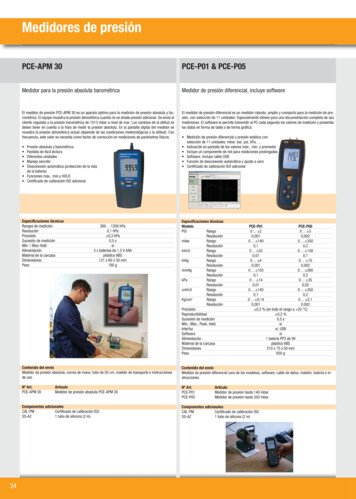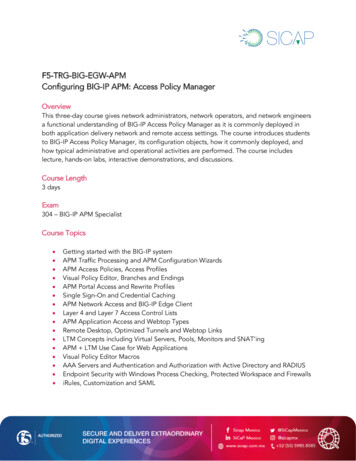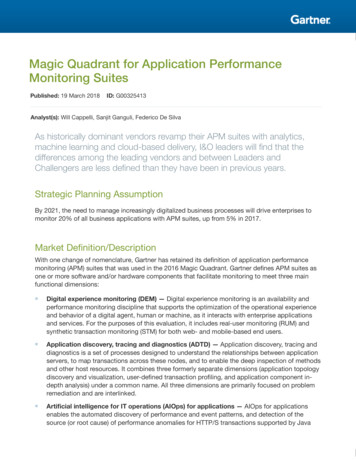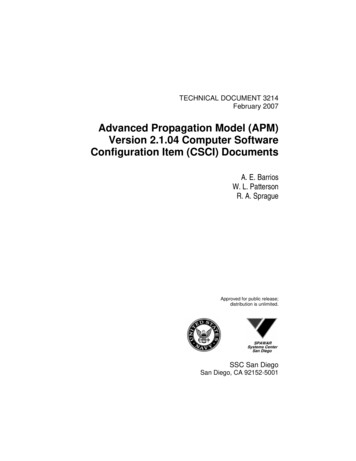
Transcription
TECHNICAL DOCUMENT 3214February 2007Advanced Propagation Model (APM)Version 2.1.04 Computer SoftwareConfiguration Item (CSCI) DocumentsA. E. BarriosW. L. PattersonR. A. SpragueApproved for public release;distribution is unlimited.SSC San DiegoSan Diego, CA 92152-5001
Form ApprovedOMB No. 0704-0188Report Documentation PagePublic reporting burden for the collection of information is estimated to average 1 hour per response, including the time for reviewing instructions, searching existing data sources, gathering andmaintaining the data needed, and completing and reviewing the collection of information. Send comments regarding this burden estimate or any other aspect of this collection of information,including suggestions for reducing this burden, to Washington Headquarters Services, Directorate for Information Operations and Reports, 1215 Jefferson Davis Highway, Suite 1204, ArlingtonVA 22202-4302. Respondents should be aware that notwithstanding any other provision of law, no person shall be subject to a penalty for failing to comply with a collection of information if itdoes not display a currently valid OMB control number.1. REPORT DATE3. DATES COVERED2. REPORT TYPEFEB 200700-00-2007 to 00-00-20074. TITLE AND SUBTITLE5a. CONTRACT NUMBERAdvanced Propagation Model (APM) Version 2.1.04 Computer SoftwareConfiguration Item (CSCI) Documents5b. GRANT NUMBER5c. PROGRAM ELEMENT NUMBER6. AUTHOR(S)5d. PROJECT NUMBER5e. TASK NUMBER5f. WORK UNIT NUMBER7. PERFORMING ORGANIZATION NAME(S) AND ADDRESS(ES)Space and Naval Warfare Systems Center,53560 Hull Street,SanDiego,CA,92152-50019. SPONSORING/MONITORING AGENCY NAME(S) AND ADDRESS(ES)8. PERFORMING ORGANIZATIONREPORT NUMBER10. SPONSOR/MONITOR’S ACRONYM(S)11. SPONSOR/MONITOR’S REPORTNUMBER(S)12. DISTRIBUTION/AVAILABILITY STATEMENTApproved for public release; distribution unlimited13. SUPPLEMENTARY NOTES14. ABSTRACT15. SUBJECT TERMS16. SECURITY CLASSIFICATION OF:17. LIMITATION OFABSTRACTa. REPORTb. ABSTRACTc. THIS PAGEunclassifiedunclassifiedunclassified18. NUMBEROF PAGES19a. NAME OFRESPONSIBLE PERSON438Standard Form 298 (Rev. 8-98)Prescribed by ANSI Std Z39-18
PREFACEThis document provides Version 2.1.04 Computer Software Configuration Item documents for theAdvanced Propagation Model (APM). The APM calculates range-dependent electromagnetic systempropagation loss and propagation factor within a heterogeneous atmospheric medium over variableterrain, where the radio-frequency index of refraction is allowed to vary vertically and horizontally.The first document specifies the functional requirements that are to be met by the APM CSCI. Adiscussion of the input software requirements is presented together with a general description of theinternal structure of the APM CSCI as it relates to the CSCI’s capability.The second document describes the design of the APM CSCI. An overview of the input softwarerequirements is presented together with an overview of the CSCI design architecture and a detaileddesign description of each CSCI component.The third document specifies the test cases and test procedures necessary to perform APM CSCIqualification testing. A discussion of precise input values of each input variable required to performthe test together with final expected test results is presented.
SOFTWARE REQUIREMENTS SPECIFICATIONFOR THEADVANCED PROPAGATION MODEL CSCI(Version 2.1.04)20 December 2006
TABLE OF CONTENTS1. SCOPE .11.1 IDENTIFICATION . 11.2 SYSTEM OVERVIEW. 11.3 DOCUMENT OVERVIEW. 12. REFERENCED DOCUMENTS .13. REQUIREMENTS .33.1 CSCI CAPABILITY REQUIREMENTS. 33.1.1 Advanced Propagation Model Initialization (APMINIT) CSC . 93.1.1.1 Allocate Arrays APM (ALLARRAY APM) SU . 103.1.1.2 Allocate Array PE (ALLARRAY PE) SU . 103.1.1.3 Allocate Array RO (ALLARRAY RO) SU . 103.1.1.4 Allocate Array XORUF (ALLARRAY XORUF) SU. 103.1.1.5 Alpha Impedance Initialization (ALN INIT) SU . 113.1.1.6 Antenna Pattern (ANTPAT) SU . 113.1.1.7 APM Status (APMSTATUS) SU . 113.1.1.8 Dielectric Initialization (DIEINIT) SU. 113.1.1.9 FFT Parameters (FFTPAR) SU . 113.1.1.10 Fill Height Arrays (FILLHT) SU. 113.1.1.11 Gaseous Absorption (GASABS) SU. 123.1.1.12 Get Effective Earth Radius Factor (GET K) SU. 123.1.1.13 Get Alpha Impedance (GETALN) SU. 123.1.1.14 Get Angles (GETANGLES) SU . 123.1.1.15 Get Maximum Angle (GETTHMAX) SU . 123.1.1.16 Grazing Angle Interpolation (GRAZE INT) SU . 133.1.1.17 Height Check (HTCHECK) SU . 133.1.1.18 Interpolate Profile (INTPROF) SU . 133.1.1.19 PE Initialization (PEINIT) SU . 133.1.1.20 Poly 4 (FN POLY4) Function . 133.1.1.21 Poly 5 (FN POLY5) Function . 133.1.1.22 Profile Reference (PROFREF) SU . 133.1.1.23 Refractivity Initialization (REFINIT) SU . 133.1.1.24 Remove Duplicate Refractivity Levels (REMDUP) SU. 143.1.1.25 RG Trace (RGTRACE) SU . 143.1.1.26 Terrain Initialization (TERINIT) SU . 143.1.1.27 Trace to Output Range (TRACE ROUT) SU . 143.1.1.28 Trace to next Step (TRACE STEP) SU . 143.1.1.29 Troposcatter Initialization (TROPOINIT) SU . 153.1.1.30 Starter Field Initialization (XYINIT) SU . 153.1.2 Advanced Propagation Model Step (APMSTEP) CSC . 153.1.2.1 Calculate Propagation Loss (CALCLOS) SU . 163.1.2.2 Current Wind (FN CURWIND) Function. 163.1.2.3 Dielectric Constant (FN DIECON) Function . 163.1.2.4 DoShift SU . 163.1.2.5 Discrete Sine/Cosine Fast-Fourier Transform (DRST) SU . 173.1.2.6 Flat-Earth Direct Ray (FEDR) SU. 173.1.2.7 Flat-Earth Model (FEM) SU . 173.1.2.8 Fast-Fourier Transform (FFT) SU . 173.1.2.9 Free Space Range Step (FRSTP) SU. 183.1.2.10 FZLIM SU . 183.1.2.11 Get Propagation Factor (FN GETPFAC) Function. 183.1.2.12 Get Reflection Coefficient (GETREFCOEF) SU. 183.1.2.13 Get Troposcatter Loss (FN GET TLOSS) Function . 19i
3.1.2.14 Linear Interpolation (FN PLINT) Function . 193.1.2.15 Mixed Fourier Transform (MIXEDFT) SU. 193.1.2.16 Parabolic Equation Step (PESTEP) SU . 193.1.2.17 Ray Trace (RAYTRACE) SU . 203.1.2.18 Refractivity Interpolation (REFINTER) SU . 203.1.2.19 Ray Optics Calculation (ROCALC SU). 213.1.2.20 Ray Optics Loss (ROLOSS) SU . 213.1.2.21 Save Profile (SAVEPRO) SU . 223.1.2.22 Spectral Estimation (SPECEST) SU . 223.1.2.23 Surface Impedance (SURFIMP) SU. 223.1.2.24 Troposcatter (TROPOSCAT) SU . 223.1.3 Extended Optics Initialization (XOINIT) CSC. 223.1.3.1 Advanced Propagation Model Clean (APMCLEAN) SU . 233.1.3.2 Clutter-to-Noise (CLUTTER) SU . 233.1.3.3 Diffraction Loss (FN DLOSS) Function . 233.1.3.4 Get Theta (GETTHETA) SU . 233.1.3.5 GIT Initialization (GIT INIT) SU. 233.1.3.6 GofZ (GOFZ) Function . 233.1.3.7 Mean Filter (MEANFILT) SU . 243.1.3.8 Optical Region Limit (OPLIMIT) SU. 243.1.3.9 Optical Difference (OPTICF) SU . 243.1.3.10 R1 Iteration (R1ITER) SU. 243.1.3.11 Standard Propagation Model Initialization (SPM INIT) SU. 243.1.3.12 Standard Propagation Model (SPM) SU . 243.1.4 Extended Optics Step (XOSTEP) CSC. 243.1.4.1 Extended Optics (EXTO) SU . 253.1.5 Return Grazing Angle (RET GRAZE) CSC. 253.2 CSCI EXTERNAL INTERFACE REQUIREMENTS . 253.3 CSCI INTERNAL INTERFACE REQUIREMENTS . 303.4 CSCI INTERNAL DATA REQUIREMENTS. 313.5 ADAPTATION REQUIREMENTS . 333.5.1 Environmental Radio Refractivity Field Data Elements . 333.5.2 Terrain Profile Data Element. 363.6 SECURITY AND PRIVACY REQUIREMENTS. 363.7 CSCI ENVIRONMENTAL REQUIREMENTS. 373.8 COMPUTER RESOURCE REQUIREMENTS. 373.9 SOFTWARE QUALITY FACTORS . 373.10 DESIGN AND IMPLEMENTATION CONSTRAINTS. 383.10.1 Implementation And Application Considerations . 383.10.2 Programming Language And Source Implementation. 393.10.2.1 Programming Language . 393.10.2.2 Source Implementation. 403.11 PERSONNEL-RELATED REQUIREMENTS . 413.12 TRAINING RELATED REQUIREMENTS . 413.13 OTHER REQUIREMENTS . 413.14 PRECEDENCE AND CRITICALITY OF REQUIREMENTS . 414. QUALIFICATION PROVISIONS.425. REQUIREMENTS TRACEABILITY .425.1 SYSTEM TRACEABILITY. 425.2 DOCUMENTATION TRACEABILITY . 426. NOTES .54ii
APPENDIX A .57A.1 DEFINITIONS OF QUALITY FACTOR CRITERIA . 57A.2 SOFTWARE QUALITY METRICS. 58A.2.1 Completeness Criteria . 58A.2.2 Consistency Criteria. 58A.2.3 Traceability Criteria . 58FIGURESFigure 1. APM calculation regions.4Figure 2. Program flow of the APM CSCI.6Figure 3. APMINIT CSC program flow. .7Figure 4. APMSTEP CSC program flow.7Figure 5. XOINIT CSC program flow.8Figure 6. XOSTEP CSC program flow. .8Figure 7. Idealized M-unit profiles (solid) and lines of interpolation (dashed).35TABLESTable 1.Table 2.Table 3.Table 4.Table 5.Table 6.Table 7.Table 8.Table 9.APM CSCI environmental data element requirements. .26APM CSCI external EM system data element requirements. .27APM CSCI external implementation data element requirements.28APM CSCI external terrain data element requirements. .29APM CSCI output data element requirements. .30APMinit SU returned error definitions.31Requirements traceability matrix for the SRS. .42Acronyms and abbreviations. .55Fortran terms. .56iii
1. SCOPE1.1 IDENTIFICATIONThe Advanced Propagation Model (APM) Version 2.1.04 computer softwareconfiguration item (CSCI) calculates range-dependent electromagnetic (EM) systempropagation loss within a heterogeneous atmospheric medium over variable terrain,where the radio-frequency index of refraction is allowed to vary vertically andhorizontally, also accounting for terrain effects along the path of propagation.1.2 SYSTEM OVERVIEWThe APM CSCI model calculates propagation loss values as EM energypropagates through a laterally heterogeneous atmospheric medium where the index ofrefraction is allowed to vary vertically and horizontally, also accounting for terraineffects along the propagation path. Numerous external applications require EM-systempropagation loss values. The APM model described by this document may be applied totwo external applications, one that displays propagation loss on a range versus heightscale (commonly referred to as a coverage diagram) and one that displays propagationloss on a propagation loss versus range/height scale (commonly referred to as a lossdiagram).1.3 DOCUMENT OVERVIEWThis document specifies the functional requirements that are to be met by theAPM CSCI. A discussion of the input software requirements is presented together with ageneral description of the internal structure of the APM CSCI as it relates to the CSCI’scapability.2. REFERENCED DOCUMENTSAmerican National Standards Institute (ANSI), “Program Language - Fortran Extended”, 1992.Barrick, D.E. 1971a. “Theory of HF and VHF Propagation Across the Rough Sea, 1. TheEffective Surface Impedance for a Slightly Rough Highly Conducting Medium atGrazing Incidence,” Radio Sci. (May), V6, no. 5, pp.571-526.Barrick, D.E. 1971b. “Theory of HF and VHF Propagation Across the Rough Sea, 2.Application to HF and VHF Propagation Above the Sea,” Radio Sci. (May), V6, no. 5,pp. 527-533.1
Barrios, A. E., “Terrain and Refractivity Effects on Non-Optical Paths,” AGARDConference Proceedings 543, Multiple Mechanism Propagation Paths (MMPPs): TheirCharacteristics and Influence on System Design, pp. 10-1 to 10-9, October 1993.Barrios, A. E., “A Terrain Parabolic Equation Model for Propagation in theTroposphere,” IEEE Trans. Antennas Propagat., Vol. 42, pp. 90-98, January 1994.Barrios, A. E., “Terrain Parabolic Equation Model (TPEM) Version 1.5 User’s Manual,”Naval Command, Control and Ocean Surveillance Center, RDT&E Division, San Diego,CA, NRaD TD 2898, February 1996.Barrios, A.E., Patterson, W.L., “Advanced Propagation Model (APM) Ver. 1.3.1Computer Software Configuration Item (CSCI) Documents”, SSC-SD TD 3145, Aug.2002.Bergland, G. D., “A Radix-eight Fast Fourier Transform Subroutine for Real-valuedSeries,” IEEE Trans. Audio and Electro-acoust., Vol. AU-17, pp. 138-144, 1969.Commander-In-Chief, Pacific Fleet Meteorological Requirement (PAC MET) 87-04,“Range Dependent Electromagnetic Propagation Models,” 1987.Cooley, J. W., P. A. W. Lewis and P. D. Welsh, “The Fast Fourier Transform Algorithm:Programming Considerations in the Calculation of Sine, Cosine and LaplaceTransforms,” J. Sound Vib., Vol. 12, pp. 315-337, 1970.Dockery, G. D., “Modeling Electromagnetic Wave Propagation in the Troposphere Usingthe Parabolic Equation”, IEEE Trans. Antennas Propagat., Vol. 36, No. 10, pp. 14641470, October 1988.Dockery, G.D, Kuttler, J.R., “An Improved Impedance-Boundary Algorithm for FourierSplit-Step Solutions of the Parabolic Wave Equation,” IEEE Trans. On Antennas andPropagat., Vol. 44, No. 12, December 1996, pp. 1592-1599.Hitney, H.V., Hattan, C.P., Paulus, R.A., Anderson, K.D., “Electromagnetic PropagationFunctions Program Performance Specification (PPS) For the Tactical EnvironmentalSupport System (TESS)”, NOSC TD 1015, Feb. 1984.Horst, M.M., Dyer, F.B., Tuley, M.T., “Radar Sea Clutter Model,”, IEEE InternationalConference on Antennas and Propagation.International Radio Consulting Committee (CCIR) XVth Plenary Assembly Dubrovnik,1986, “Propagation in Non-Ionized Media,” Recommendations and Reports of the CCIR,1986, Vol. V, International Telecommunications Union, Geneva, 1986.2
Kuttler, J. R. and G. D. Dockery., “Theoretical Description of the ParabolicApproximation/Fourier Split-Step Method of Representing Electromagnetic Propagationin the Troposphere,” Radio Sci., Vol. 26, pp. 381-393, 1991.Miller, A.R., R.M. Brown, E. Vegh,”New Derivation for the Rough-Surface ReflectionCoefficient and for the Distribution of Sea-Wave Elevations” Proc. IEEE, Vol. 131, PartH, 2, 1984, pp 114-116.Naval Oceanographic Office, “Software Documentation Standards for EnvironmentalSystem Product Development,” February 1996.Patterson, W.L., Hitney, H.V., “Radio Physical Optics CSCI Software Documents”,Naval Command, Control and Ocean Surveillance Center, RDT&E Division, San Diego,CA, NRaD TD 2403, December 1992.Sailors, D.B. 1997. “Excess System Power Available for Short-Range High-FrequencyCommunication Systems,” NRaD TD-2978 (August), Naval Command, Control andOcean Surveillance Center RDT&E Division, San Diego, CA.Sailors, D.B., Barrios, A.E., “Terrain Parabolic Equation Model (TPEM) ComputerSoftware Configuration Item (CSCI) Documents”, Naval Command, Control and OceanSurveillance Center, RDT&E Division, San Diego, CA, NRaD TD 2963, May 1997.Sailors, D.B. Barrios, A.E., Patterson, W.L., Hitney, H.V., “Advanced PropagationModel [Ver. 1.0] (APM) Computer Software Configuration Item (CSCI) Documents,”SPAWARSYSCEN-SD TD 3033, August 1998.Tappert, F. D., “The Parabolic Approximation Method,” Wave Propagation andUnderwater Acoustics, J. B. Keller and J. S. Papadakis, Eds., New York, SpringerVerlag, pp. 224-285, 1977.3. REQUIREMENTS3.1 CSCI CAPABILITY REQUIREMENTSThe required APM CSCI propagation model is a range-dependent true hybridmodel that uses the complimentary strengths of Ray Optics (RO) and Parabolic Equation(PE) techniques to calculate propagation loss both in range and altitude.The atmospheric volume is divided into regions that lend themselves to theapplication of the various propagation loss calculation methods. Figure 1 illustrates theseregions.3
Figure 1. APM calculation regions.For antenna elevation angles above 5 degrees or for ranges less thanapproximately 2.5 kilometers (km), a flat-earth (FE) ray-optics model is used. In thisregion, only receiver height is corrected for average refraction and earth curvature.Within the RO region (as defined by a limiting ray), propagation loss is calculatedfrom the mutual interference between the direct-path and surface-reflected raycomponents using the refractivity profile at zero range. Full account is given to focusingor de-focusing along direct and reflected ray paths and to the integrated optical pathlength difference between the two ray paths, to give precise phase difference, and, hence,accurate coherent sums for the computation of propagation loss.For the low-altitude region beyond the RO region, a PE approximation to theHelmholtz full wave equation is employed. The PE model allows for range-dependentrefractivity profiles and variable terrain along the propagation path and uses a split-stepFourier method for the solution of the PE. The PE model is run in the minimum regionrequired to contain all terrain and trapping layer heights.For the area beyond the RO region but above the PE region, an extended opticsregion (XO) is defined. Within the XO region, ray-optics methods that are initialized bythe PE solution from below, are used.APM will run in three “execution” modes depending on environmental inputs.APM will use the FE, RO, XO, and PE models if the terrain profile is flat for the first2.5 km and if the antenna height is less than or equal to 100 m. It will use only the XOand PE models if the terrain profile is not flat for the first 2.5 km and if the antenna4
height is less than or equal to 100 m. For applications in which the antenna height isgreater than 100 meters, a combination of FE and PE methods are used. The FE model isused for all propagation angles greater than 5º from the source and the PE model is usedfor angles within 5º. By default, APM will automatically choose which mode ofoperation it will use for a specified set of inputs. However, the ability to run only the PEmodel for any case is allowed by setting a logical flag upon input. APM willautomatically run only the PE algorithm for frequencies less than 50 MHz, regardless ofthe logical flag set by the user.The APM CSCI allows for horizontal and vertical antenna polarization, finiteconductivity based on user-specified ground composition and dielectric parameters, andthe complete range of EM system parameters and most antenna patterns required byvarious external applications. APM also allows for gaseous absorption effects in all submodels and computes troposcatter losses within the diffraction region and beyond.The program flow of the required APM CSCI is illustrated Figure 2. Note thatthe APM CSCI is shown within the context of a calling CSCI application such as one thatgenerates a coverage or loss diagram. The efficient implementation of the APM CSCIwill have far reaching consequences on the design of an application CSCI beyond thosementioned in Section 3.10. For example, Figure 2 shows checking for the existence of apreviously created APM output file prior to the access of the APM CSCI. Theapplication CSCI will have to consider if the atmospheric or terrain environment haschanged since the APM output file was created or if any new height or range requirementis accommodated within the existing APM CSCI output file. Because these and manymore considerations are beyond the scope of this document to describe, an applicationCSCI designer should work closely with the APM CSCI development agency in theimplementation of the APM CSCI. Figure 3 through Figure 6 illustrate the program flowfor the main compute software components (CSC), APMINIT CSC, APMSTEP CSC,XOINIT CSC, and XOSTEP CSC, respectively.5
Figure 2. Program flow of the APM CSCI.6
Figure 3. APMINIT CSC Program flow.Figure 4. APMSTEP CSC Program flow.7
The APM CSCI is divided into 4 main computer software components (CSC) and47 additional software units (SU). The name, purpose, and a general description ofprocessing required for each SU follows.Figure 5. XOINIT CSC Program flow.Figure 6. XOSTEP CSC Program flow.8
The APM CSCI is divided into 5 main computer software components (CSC) and67 additional software units (SU). The name, purpose, and a general description ofprocessing required for each SU follows.3.1.1 Advanced Propagation Model Initialization (APMINIT) CSCThe APMINIT CSC interfaces with various SUs for the complete initialization ofthe APM CSCI.The atmospheric volume must be “covered” or resolved with a mesh ofcalculation points that will normally exceed the height/range resolution requirements ofthe particular application of the APM CSCI. Upon entering the APMINIT CSC, a rangeand height grid size per the APM CSCI output point is calculated from the number ofAPM outputs and the maximum CSCI range and height.A TERINIT SU is referenced to examine the terrain profile. The minimum terrainheight is determined, and then the entire terrain profile is adjusted by this height so thatall internal calculations are referenced to this height. This is done in order to minimizethe required PE transform size.User-specified environmental and system parameters are examined to determine ifthe APM CSCI will execute in a full hybrid mode, a partial hybrid mode, or PE-onlymode.A REFINIT SU is referenced to initialize the external CSCI specified modifiedrefractivity and also to test for valid environment profiles. A PROFREF SU adjusts theenvironment profiles by the internal reference height, and a INTPROF SU defines themodified refractivity at all PE vertical mesh points.If rough surface calculations are required (i.e., a non-zero wind speed is specified)a GETANGLES SU is referenced to determine the grazing angles for the givenrefractivity profile. The grazing angles are then sorted and a GRAZE INT SU isreferenced to combine grazing angles computed by both methods (if necessary) andinterpolate for subsequent use in rough surface calculations.To automatically determine the
The APM CSCI model calculates propagation loss values as EM energy propagates through a laterally heterogeneous atmospheric medium where the index of refraction is allowed to vary vertically and horizontally, also accounting for terrain effects along the propagation path. Numerous external applications require EM-system
